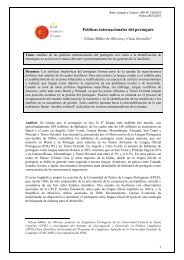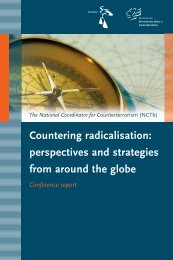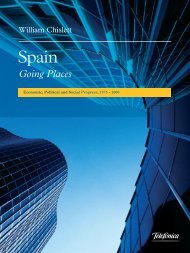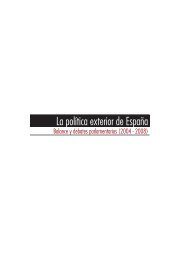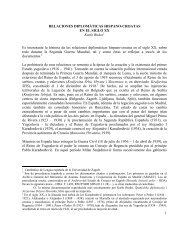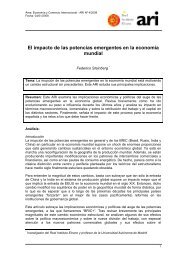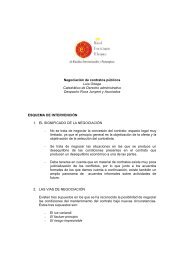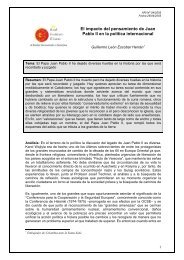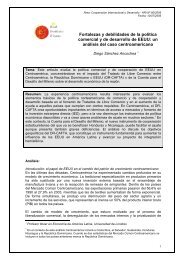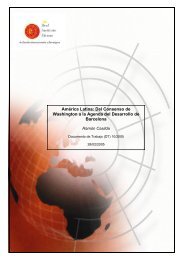they represent the changes that are taking place in the world.’ 15 The debate on what the term ‘left’means is not exclusive to our region, but rather extends to Europe, as Ulrico Beck states when hetalks (in the European context) of four ways of being leftist: protectionist, neo-liberal (Third Way),one who lives enclosed within a citadel, and the cosmopolitan leftist. 16 We feel there is no solidevidence that the region is taking a turn to the left. Dividing politics into right and left, besidesbeing out of sync in terms of time, causes more confusion than clarity. As former president RicardoLagos said, rather than a shift to the left, the region is undergoing a deepening of the democraticsystem. Voters are seeking options that will help them fix unresolved problems. Rosendo Fragasays it this way:In political terms, 2006 was a year of presidential elections in which 85% of the region voted andthere was an ideological shift toward the centre, with three clearly defined lines: Social Democrat,populist left and centre-right. The re-election of Lula in Brazil and the election of Bachelet in Chileconfirmed the existence of a Social Democratic axis which Uruguay also joined. Meanwhile, theBolivarian Alliance of the Americas (ALBA), founded by Venezuela and Cuba, incorporatedBolivia, Ecuador and Nicaragua, although the new president of the latter (Ortega) announced hewill not abandon the free-trade accord that Central America and Santo Domingo signed with theUS. At the same time, a third centre-right force emerged unexpectedly with the triumphs ofCalderón in Mexico and Alan García in Peru – with its new turn in this direction - which, alongwith Colombia and the majority of the countries in Central America constitute an axis with a coastoverlooking the Pacific, close to Washington in political terms. 17According to the argument expressed by former president Lagos, Latin America is approaching anew era. Whereas before the goal was to grow (and this is being done nicely) now the priority is todefine what model of society we want to build. So, rather than a shift to the left, it is more accurateand correct to speak of a search for new options in the framework of a deepening of democracy. Itis a democracy which in some cases can have an authoritarian or plebiscitary slant, with strongpopulist components and objectives that are a bit all-encompassing.The electoral system: run-offs and concurrent electionsDuring the period under study, much use was made of the run-off mechanism for electingpresidents. There are opinions for and against this system. Its defenders point to two fundamentaladvantages: 1) it is said to strengthen the electoral legitimacy of the president, not only because itguarantees this person has broken through a minimum electoral threshold but also because it allowsthe electorate to decide the race in the event no candidate surpasses that threshold in the first roundof voting; 2) as a result of this first point, the system would tend to strengthen democraticgovernance by guaranteeing election of a president with broad popular support and promotingelectoral coalitions between the first and second rounds that can easily turn later into governingcoalitions.Critics of the run-off system argue that the second round hardly ever lives up to these promises.They say that first of all, the alleged legitimacy stemming from broad electoral support can beartificial and unstable. On the other hand, critics say the second round generates fewer incentivesfor strategic voting: voters can cast ballots for their favourite candidate in the first round, albeit withscant probability of victory, without worrying too much about an undesired candidate winningbecause in the mind of the voter this is put off until the second round. According to this argument,the two-round system favours an increase in the number of parties, a process which over the longterm will tend to fragment the electorate. Despite this debate, the two-round voting system has beenincorporated into the legislation of most of the countries of the region. Thirteen countries use it,15 Francisco Rojas Aravena, ‘The new Latin American political map. Rethinking the factors that mark political trenes’,Nueva Sociedad, Buenos Aires, 2005, p. 125.16 Ulrich Beck, El País, Madrid, 17/11/2006, p. 13.17 Rosendo Fraga, ‘Three trends in the region’, La Nación, Buenos Aires, 17/1/2007, p. 3.11
although with important differences in how: Argentina, Bolivia, 18 Brazil, Chile, Colombia, CostaRica, Ecuador, El Salvador, Guatemala, Nicaragua, Peru, the Dominican Republic and Uruguay.The ones that do not have it are Honduras, Mexico, Panama, Paraguay and Venezuela.Of the 11 presidential elections that were held during the period under study, eight were conductedwith the two-round system. Of these, in half the cases a run-off was needed (Brazil, Ecuador, Chileand Peru) while in the other four a winner emerged in the first round of voting (Bolivia, Costa Rica,Colombia and Nicaragua). In the cases of Costa Rica and Nicaragua, the electoral system stipulatesreduced margins for winning in the first round (40% of the votes in both cases, or in the case ofNicaragua 35% with a margin off 5% over the person in second place), which facilitated the victoryof Arias and Ortega in the first round. Otherwise, had a classical two-round system been in place(winner needs 50 percent plus one vote) in both countries there would have been a run-off election.As observed in Table 6, of the four cases in which it was necessary to go to a second round, in twoof them the final result went against the first-place finisher of the first round. In Peru, the candidatewho finished second in the first round, (Alan García) ended up winning, and the same thinghappened in Ecuador, where Rafael Correa triumphed over Álvaro Noboa, who had won the firstround of the election.As for the nature of concurrent or off-year legislative elections, it is worth pointing out that in thevast majority of the presidential elections, legislative voting was held at the same time. In ninecountries the legislative and presidential elections were simultaneous. The only countries that didnot hold concurrent elections were Colombia (it held them two months before the presidentialvoting, a typical case of what are known as semi-concurrent elections) and Venezuela (in December2005).Table 6. Latin American voting systems in elections of 2005-2006Country Electoral systemElection result 2005-2006First roundSecond roundBolivia Two rounds, with majority Evo Morales —Brazil Two rounds, with majority1. Luiz Inácio da Silva2. Geraldo AlckminLuiz Inácio da SilvaChileTwo rounds, with majority1. Michelle Bachelet2. Sebastián PiñeraMichelle BacheletColombia Two rounds, with majority Álvaro Uribe —PeruTwo rounds, with majority1. Ollanta Humala2. Alan GarcíaAlan GarcíaCosta RicaTwo rounds, with reducedthresholdOscar Arias —EcuadorTwo rounds, with reduced 1. Álvaro Noboathreshold2. Rafael CorreaRafael CorreaNicaraguaTwo rounds, with reducedthresholdDaniel Ortega —Honduras Simple majority Manuel Zelaya n/aMexico Simple majority Felipe Calderón n/aVenezuela Simple majority Hugo Chávez n/an/a: not applicableSource: the author18 In Bolivia, the second round is held in Congress. This is done if no candidate wins an absolute majority in the firstround. The second round in the legislature requires an absolute majority of the lawmakers present in order to elect anew president.12



